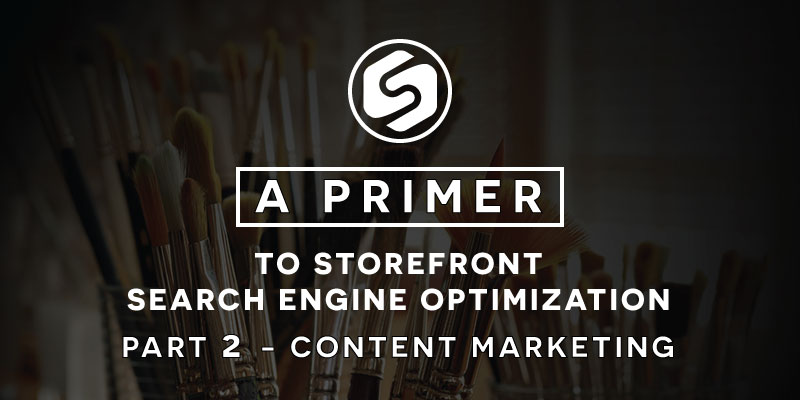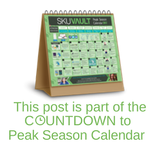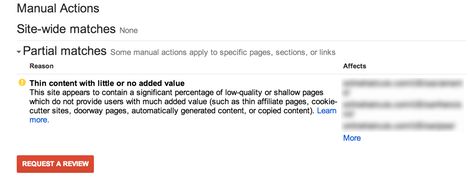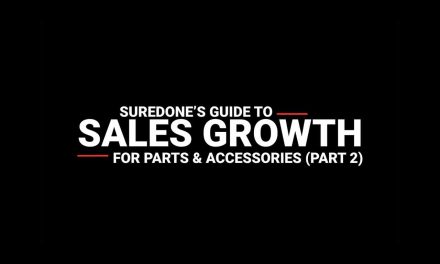
Content Marketing – A Primer to Storefront Search Engine Optimization Part 2

 In Part 1 of this series we discussed the foundation of e-Commerce and storefront search engine optimization – the importance of ranking on Google and what your goals should be.
In Part 1 of this series we discussed the foundation of e-Commerce and storefront search engine optimization – the importance of ranking on Google and what your goals should be.
In this part of the series we’re going to specifically focus on what is considered the current approach to ranking your site – content marketing. When we get to Part 3, we’ll be discussing link building.
What Is Content Marketing?
Content marketing is literally what it sounds like. It means creating great relevant content on your website. The word  “relevant” is very, well, relevant here. Google doesn’t like it when you post irrelevant information on your website, so putting an article on the history of the Superbowl on a website about clothing wouldn’t make much sense. Google could actually lower your rankings for articles like that. However, an article on the evolution of football uniforms, or on the ten coolest team football jersey’s, would be appropriate on a clothing website. Especially if you sold team branded clothing.
“relevant” is very, well, relevant here. Google doesn’t like it when you post irrelevant information on your website, so putting an article on the history of the Superbowl on a website about clothing wouldn’t make much sense. Google could actually lower your rankings for articles like that. However, an article on the evolution of football uniforms, or on the ten coolest team football jersey’s, would be appropriate on a clothing website. Especially if you sold team branded clothing.
But what is “content”? In its simplest form (and least expensive to create), it can be articles and blog entries about a subject. Google loves these, Especially when they contain links to other sources of authority (e.g. links you used to do your research), pictures and other multimedia items. Google likes to know you’ve done  your research, and they have algorithms to verify this. You can’t just make stuff up, and it can’t be what’s called “thin” content – content that doesn’t really inform the user or leave them with anything more than they already knew.
your research, and they have algorithms to verify this. You can’t just make stuff up, and it can’t be what’s called “thin” content – content that doesn’t really inform the user or leave them with anything more than they already knew.
But there are other forms of content. Here are some of the most popular: Infographics, Videos, Lists (think top 10 ways for…), curative posts (here are ten resources for…), guides, surveys, interviews, giveaways, awards, contests (best pictures, best videos, etc.), widgets (embed our “Time until the Superbowl countdown clock” on your website), and news articles.
The Elements of an Article
We’ll talk about the “marketing” component of content marketing in a moment, but first let me talk about the important elements of blog entries and articles:
- You should pick a primary topic as opposed to dancing around several related topics.
- It’s a bit old school, but you should pick a few different phrases that you would like the article to rank for, and repeat this 5-10 times throughout the article. For example, this article is about hot to rank your e-Commerce website, and we’d love for people to be able to search for “how to rank my e-commerce website” and find this.
- It should be at least 750 words in length.
- It should include pictures to illustrate your message.
- It should include links to other websites that are relevant to the topic you are discussing – preferably not Wikipedia links but rather links to journals, respected blogs and other genuine non-spammy websites.
- It should be relevant to your website in some way.
- You should break it into multiple sections and use headlines to explain what each section is about (for those of you that know HTML, we recommend the use of H2 or H3 tags for headlines – you should only have a single H1 tag on a page).
There are many more articles on the web about creating this type of content. We highly recommend that you do your research.
How Much Content do I Need?
This is where it gets interesting, because the phrase “less is more” does not apply here. HubSpot performed a research study on the impact of monthly blog posts on inbound traffic and made some startling discoveries. Here are some of the stats:
- Companies that published 401+ total posts on their site generated 3x more traffic and 3x more leads as companies that published 0-100 total posts.
- Companies that published 16+ blog posts per month generated 3.5x more traffic than those that published 3-4 posts per month and 4.5x more leads.
So – it’s important to post a lot of content and to do it frequently. “But we’re a small business and don’t have time to write!” you might say.
There are actually numerous individuals and companies you can hire to write the content for you. Expect to pay between $25  and $75 for a 1,000 word article depending on the knowledge required, the amount of research that needs to be done and the quality of the writing you need. Around $35-$45 should get you a pretty decent article on a non-academic subject, with links to other sites. If you’re going to hire someone to do your writing, make sure to get samples of their writing first, and make sure to give them explicit instructions on everything from tone (i.e. conversational, academic, informal, etc.), key words and phrases, links that shouldn’t be included (like your competitors), etc.
and $75 for a 1,000 word article depending on the knowledge required, the amount of research that needs to be done and the quality of the writing you need. Around $35-$45 should get you a pretty decent article on a non-academic subject, with links to other sites. If you’re going to hire someone to do your writing, make sure to get samples of their writing first, and make sure to give them explicit instructions on everything from tone (i.e. conversational, academic, informal, etc.), key words and phrases, links that shouldn’t be included (like your competitors), etc.
Do a search for content writers on Google, or you can put “bids” out for the job at a site like www.upwork.com or www.freelancer.com. These are also great sites to find people to create infographics and illustrations.
What About the “Marketing” in “Content Marketing”?
It’s great to have great content, but if nobody knows it exists then it’s kind of a moot point. It’s kind of like opening a store in the middle of nowhere and then not telling anybody where you are. The more billboards you have, the more TV advertisements, the more buses that go by with information on who you are and where you are, the more people will visit this store in the middle of nowhere.
Content marketing is pretty much the same thing. You’re getting the word out about the new and interesting articles on your site, and you’re encouraging people to come check them out.
There are numerous ways to get the word out, and here are a few in order of cost (least costly first, most costly last):
- Including a variety of social share buttons on your article for viewers to share it with their own audiences
- Local and National News (hard to get publicity, but it’s free!)
- E-Mail blasts (use products like MailChimp to push out your message daily, weekly, monthly to subscribers)
- Social Media (consider using a product like HootSuite to pre-schedule pushing your new content to all of your social media)
- Press Releases (sites like PRNewsWire and PRWeb can push your press releases out to hundreds of sites for a fee)
- Pay Per Click (PPC)/Social Ads (Google AdWords, Facebook Ads, Twitter Ads, etc. – this strategy can work great but you need to balance the cost vs. profits)
- Link Building (We’ll discuss this in Part 3)
The object is to do more than just get your message out to the first round of people. You want those people to then share your article with others. This is sometimes called “viral marketing”. The more interesting you make the headline of your article (Buzzfeed has this formula perfected for the moment) and also the content, the more likely it is to be shared with others.









